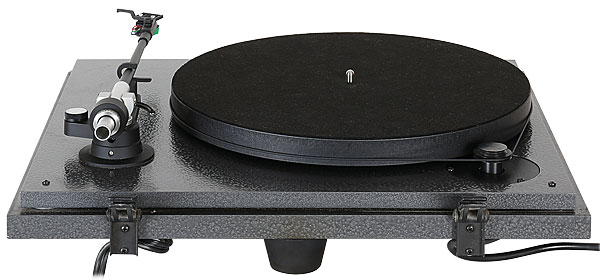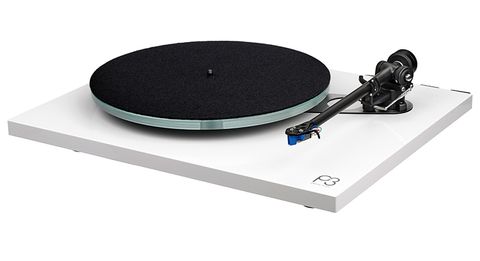The Revolver turntable, designed by Sundown Electronic Engineering, Ltd. (also known as The SEE Corporation) in Warrington, England, was aimed at a very specialized segment in the budget audiophile turntable market in the 1980s. It was distributed through a network of small, independent specialty hi-fi stores.
When you took into account the expense of an entry-level tonearm, it was essentially a direct competitor to the £148 Planar 3. If you weren’t a Linn/Naim/Rega dealer, you’d want to sell Revolvers to your poor audiophile clientele and Roksans, Pink Triangles, and possibly Oracles to your wealthy ones. In other words, this turntable was in the right place at the right time, and it offered a well-balanced set of features that appealed to both vinyl collectors and dealers.
This was a British-made specialty belt drive that made excellent use of inexpensive materials – mostly MDF – to achieve maximum sonic effect. Many individuals acquired them as their first ‘serious’ turntable, and/or as a replacement for decks that were frequently lauded by the enthusiastic hi-fi press at the time, but were no better, if not worse.
It’s basically a sheet of medium density fiberboard that’s been split in half, with two firm foam rubber strips separating the two halves. The motor, turntable bearing/platter, and tonearm are all housed on the top platform, which has ‘rumble cancelling’ lead weights that pass through clearance holes in the lower platform. This quickly distinguishes it from the Rega Planar series of decks, which have no suspension other than three vibration-absorbing feet. In a sense, it aspires to provide at least some of the isolation that a properly suspended subchassis deck may provide without resorting to actual springs.
Before the new turntable could be used for the first time, the steel shafted, brass sleeved main bearing required a fresh drop of the company-supplied oil, and the platter took a long time to fall to the correct operational height due to its close tolerances. Revolver also suggested that the deck be “run in” for a few hours before use; it’s reasonable to assume that you’ve done this on any deck you own by now! The deck came with a felt-like design comprised of polyester fibers with finely separated carbon particles, which Revolver dubbed the Starmat (for Standard Analogue Record Mat). The assumption was that it would drain static charge to the deck’s ground via the spindle because it was electrically conductive. The record was thought to be further decoupled from the deck because the mat was effectively full of air. Finally, ‘the PIG,’ a little rubber clamping device whose name was an abbreviation for Precision Instant Grip, was included. The power switch is positioned on the top platform’s front left.
Martin Colloms characterized the deck as having “above average” sound, noting it was “nicely balanced…” in his 1984 book Hi-Fi Choice: Turntables and Tonearms. There was no boom or emphasis in the bass… The stereo depth was good, and the viewpoint was enjoyable.” This is difficult to argue with; the deck isn’t in the top tier of turntables, and you wouldn’t expect it to be, but it punches far above its weight and, when paired with a quality tonearm, is perhaps better than a similarly priced Rega Planar 3 of the time.
A belt-driven turntable built of MDF can only sound warm and fluffy in one manner. The Revolver, on the other hand, wasn’t as soft around the edges as you might assume, and it was able to put up a good fight with forceful, dynamic music. Not least because the two-tier plinth system didn’t retain energy as well as some decks, it didn’t come across as the hi-fi equivalent of a pair of nice old carpet slippers. In fact, the bass was tight and lithe, with plenty of bounce in the manner it handled a bassline.
The midband featured a good amount of detail, although it was slightly opaque, giving it a soft-around-the-edges feel. However, one wonderful feature of this deck was its depth perspective. It managed to produce a more three-dimensional, immersive sound than anything else at its pricing point, if not a little more. Treble was lovely and smooth towards the top, if a little muted.
The lack of speed steadiness is the most obvious characteristic that ages it. Don’t get me wrong: it doesn’t sound unsteady, but it also doesn’t have the totally pitch-perfect sound of digital music that we’ve all grown accustomed to; there’s a touch of ‘fluffiness’ to its presentation that many will enjoy and regard as a positive, ‘analogue’ trait. In its defense, it was a little bit more solid-sounding than the Rega Planar 3 decks of the time, though Rega’s current decks are way, much better in this regard.
Colin and Wyn Higham founded Revolver in 1979, and the company manufactured a variety of decks based on the Revolver concept for the next thirteen years. They provided better-built Rebels with rosewood finishes, as well as the low-cost Rebel with a number of cost-cutting features. Colin Higham was forced to resign due to sickness before the end of 1990, and the company was closed.
Peter Ratchford and Ray Nugent dutifully purchased the trading rights, and Revolver UK Ltd. dutifully launched a variety of extremely acceptable sounding but rather odd speakers produced for them by JPW Loudspeakers in 1994. The company was sold to an electronics company in 1998, and the speakers were discontinued. However, in 2002, former Heybrook employee Mike Jewitt and Charles Greenlees, formerly of JPW, founded The Acoustic Partnership and resurrected the brand, including manufacturing the turntable. Graeme Holland of Audion took control in January 2012. The Rebel 2 was selling for £995 at the time.
Overall, this is an intriguing turntable curio; a product that was nearly omnipresent in the late 1980s and early 1990s, but has since largely been forgotten. Perhaps it’s because the Revolver was always a stepping stone to something better; so many people used it as a stepping stone on the hi-fi upgrading ladder; a temporary tool to use until a better disc spinner could be found. It’s a fascinating and weird little turntable by today’s standards, and it’s the sonic match of middle-ranking Pro-Jects, but it has something they don’t. It’s a charming little record spinner that’s plenty good enough to appreciate any excellent LP collection with in its own minimalist eighties manner.






